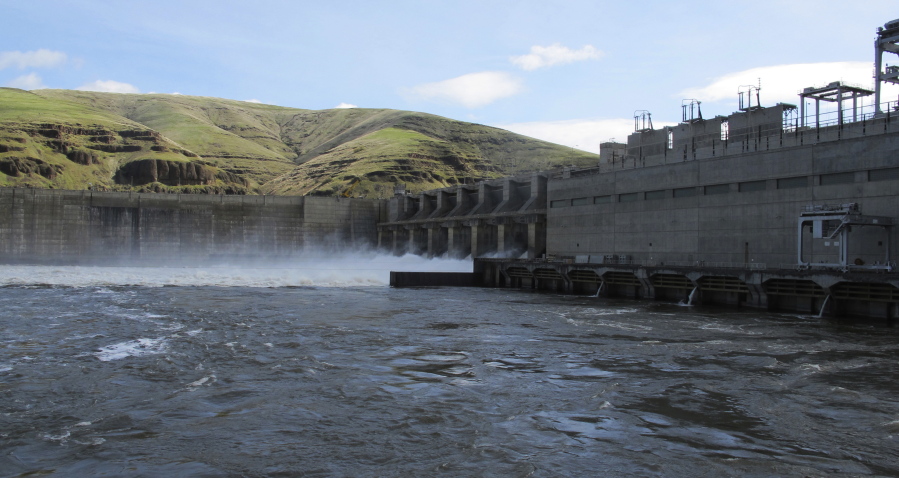LONGVIEW — A new study commissioned by an association of river commercial groups says removing the four Lower Snake River dams to improve salmon runs would cost $2.3 billion over the next 30 years, boost state carbon emissions and jeopardize already fragile local and regional economies.
“Dam breaching extremists talk about how easy and inexpensive it would be to compensate Washington, Oregon and Idaho businesses and residents if the lower Snake River dams were removed,” PNWA Executive Director Kristin Meira said Monday. “We commissioned this study to show federal and state decision makers the real economic and environmental impacts on real people and communities that would result.”
The report considers how breaching would affect regional and national transportation; infrastructure; air quality; safety; and tax revenue. It does not consider the effects on hydropower, irrigation, salmon or other dam and river uses.
“We weren’t trying to capture everything. … This study is just looking at barging,” Meira told The Daily News on Monday. “Transportation and the use of waterways for movement of people and goods is a big focus of our organization. … But no one else was out there doing that kind of analysis.”
Ship locks on the dams make barging commodities such as grain and wood chips possible through the Snake and Columbia River system. They would not be functional if the dams are breached.
An earlier report by environmental groups argues that benefits to salmon and recreation outweigh economic losses of dam breaching. And removing the dams could cost less than efforts to make the dams more friendly to fish. (Dams are friendlier to salmon than they used to be, but runs have continued to struggle for many reasons.)
“Spending $2.3 billion over the next three decades … to remove dams and upgrade our roads and bridges sounds expensive. But it could be cheaper, and more effective, than the $16 billion we’ve already squandered trying to restore salmon with the dams in place,” said Miles Johnson, senior attorney with Columbia Riverkeeper. (The $16 billion figure applies to salmon-protection measures throughout the main stem Columbia and Snake rivers, not just the Snake.)
Economic consultants FCS Group released the study Monday on behalf of PNWA — a coalition of ports, businesses, public agencies and individuals supportive of regional river commerce.
The study pulls from 14 interviews with regional farmers, shippers, port managers and agricultural trade groups, as well as data from state agencies in Washington and Idaho.
According to the report, breaching the dams would require at least 201 additional unit trains and 23.8 million miles in additional trucking activity annually to maintain current shipping activities. To accommodate the increased rail and truck shipping, federal investments between $1.17 billion and $2 billion in road and rail improvements, the report says.
“No funding for these improvements has been identified, and all of these improvements are considered to be national costs that would not otherwise be required if the LSR (Lower Snake River) locks remain in operation,” the report says.
Shipping by rail and truck is more expensive than barging, so costs for regional farmers would also increase. The report estimates that more than 1,100 farms could go bankrupt if federal subsidies do not increase to offset those costs.
It would take between $18.9 million and $38.8 million more in federal funding to keep farm profits level, the report says.
Without those subsidies, nearly 4,000 jobs and $472.7 million in sales supported by agricultural exports from the 10-county region nearest to the dams could vanish. Thousands more jobs in tourism, paper manufacturing, munition manufacturing, water transportation, lumber mill and wholesale trade would also be put at risk. (The report did not evaluate the potential loss of indirect jobs downriver in Cowlitz or Clark counties.)
Removing the dams also would significantly increase air pollution, because shipping by rail or truck is dirtier than by tug and barge. The report estimates carbons emissions would increase by about 860,000 tons, the equivalent of adding almost 182,000 new cars to the road.
“It just seems counter to the way we are all thinking about the environment these days to want to go in the direction of putting more carbon and emissions in the air,” Meira said.
The PNWA report comes about five months after another dam study by Seattle-based economics firm ECONorthwest concluded that dam removal would create 317 new jobs, $408 million in labor income and other wealth. There would be some job shifting, though.
PNWA blasted the report when it came out, saying it “lacks science-based evidence.” Meira on Monday said the PNWA report uses data and scientific assessment in a way the ECONorthwest report didn’t.
“The big numbers you saw in the ECONorthwest report were due to phone calls that were made to people in the Northwest asking them to think about what a free flowing Snake River would be worth to them. We don’t think this is a scientifically valid way of assessing the value of a river system,” Meira said. “In contrast, our study uses existing, verified data that is available publicly.”



